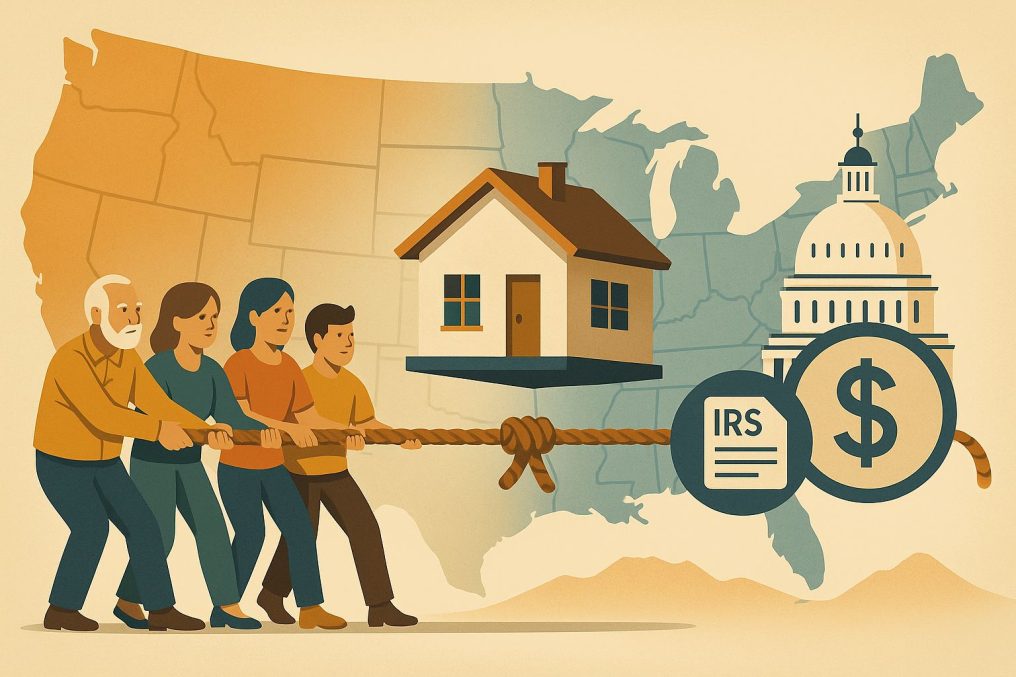By Syndie Eardly
Congress is entertaining several proposals this year to modify current capital gains tax regulations on the sale of homes, and the real estate industry is championing the proposals, hoping more generous exemptions will encourage long-term owners to put their homes on the market.
But would such a change in the law be enough to move the needle? To explore that question, we’ll consider the current capital gains structure, and the proposals under consideration.
How current capital gains are assessed
The Taxpayer Relief Act of 1997 set the current exemption levels for the sale of a primary residence, which allows a sole owner to exclude up to $250,000 in capital gains and a married couple filing jointly to exclude up to $500,000 from their tax liability.
These gains can be reduced by showing proof of capital upgrades, which include new additions, garages or porches; new roof, siding, driveway or deck; energy efficient upgrades such as insulation, solar or siding; and replacing major systems such as furnace, central air, electrical or plumbing systems.
What was not included in the original legislation was any consideration for inflation. Realtor.com estimates that in the nearly 30 years since the law was passed, home values have climbed more than 260%.
Proposed legislation
There have been three bills introduced in 2025 to address the outdated capital gains tax threshold:
The More Homes on the Market Act of 2025 (H.R.1340)
Introduced in February, the bill would increase the exclusion for capital gains for sole owners from $250,000 to $500,000 and for couples from $500,000 to $1,000,000. The bill also includes a provision that would adjust these numbers over time for inflation. This bipartisan bill may have the best chance of passing, and proponents believe it could have an impact not only on the current availability of homes for sale but also ensure future supply.
Capital Gains Inflation Relief Act of 2025 (S. 798)
Also introduced in February, the bill would index capital gains to inflation, and while the bill is broad in its reach, it does include the sale of property and so would provide some relief to home sellers. This bill is complicated, however, because it impacts such a wide swath of capital gains taxes and is likely to lag in Congress, promising no quick fix for the housing market.
No Tax on Home Sales Act
Introduced in August, this bill would eliminate capital gains entirely on the sale of all primary residences. The downside is that it would cost the federal government billions in lost revenue, which would likely need to be offset by higher taxes elsewhere.
Who benefits?
Assessing the market impact of these proposals also requires asking how widely the effects would be felt among homeowners, and whether the number is large enough to meaningfully shift housing supply. To understand who would benefit from any adjustment to the capital gains tax, it’s important to look at the sectors of homeowners who have accrued capital gains that exceed the current thresholds.
It is estimated that about 25% of current homeowners – sole and couple ownership – have realized a $250,000+ gain since purchasing their home. According to the National Association of Realtors, approximately 38% of homeowners are single owners, so only that percentage of current homeowners would be subject to the $250,000 threshold. Approximately 8% have realized a gain exceeding $500,000.
Given the benefit accrued to married couples, this calculates out to approximately 10% of current homeowners who would actually have a capital gains burden if selling their home under the current regime.
A recent estimate prepared by The Budget Lab at Yale University seemed to concur with these numbers, estimating that only 10.3% of homeowners are above the current exception. The report indicated that those who would benefit would be wealthier, higher-income and older on average, noting that the average net worth of those homeowners is $5.7 million, their average income is $431,000, and the average age is 64.
A Redfin report came to a similar conclusion, noting that the median value of homes that have gained $500,000 is approximately $1.3 million, while the median home value for those homes that have gained $250,000 is $720,000, indicating that those most impacted by the current rates are also among the wealthiest homeowners.
Homeowners on the East and West Coasts, where home values have climbed most rapidly over the past several decades, are also more likely to benefit.
California, Hawaii, Massachusetts, Washington, New Jersey, Rhode Island, New Hampshire, Utah, Idaho and Colorado are the states with the highest share of homes above capital gains thresholds. States in the heartland report negligible numbers exceeding the gains threshold, including Kentucky, Indiana, Nebraska, Louisiana, West Virginia, Wyoming, Oklahoma, Iowa, North Dakota and Mississippi.
How a higher threshold (or no threshold) benefits the real estate market
While there appears to be agreement that the current thresholds are outdated, and likely to penalize long-time elderly homeowners, particularly those who have been widowed, there is less of an understanding of how effective the legislation will be at releasing more homes into the market – a major concern for the real estate industry.
Although the current inventory of homes for sale is in the 4.6-month range, that inventory could be gobbled up very quickly if the Federal Reserve continues to dial back rates and homebuyers who have sat on the sidelines head back into the market in greater numbers.
From a long-term perspective, raising the threshold seems imperative, as more homeowners will cross that threshold in the coming years if the adjustment is not made, incentivizing a larger number of long-term owners to stay put.
The National Association of Realtors commissioned new studies that found:
- By 2030, 56% of homeowners (47 million) are projected to exceed the $250K threshold— and nearly 23% (20 million) could surpass $500K.
- By 2035, nearly 70% (59 million) could surpass $250K and 38% exceed $500K cap.
- Eight states could have more than 40% of owners above the $500K cap by 2030; 20 states by 2035.
However, if the change reaches only 10% of current homeowners, most in higher-income tiers, its effect may be modest. Raising the exclusion might release some upper-tier homes, but it may not resolve the fundamental shortage of affordable housing for lower- and middle-income consumers.
Potential homebuyers may still be on the sidelines in 2026 if the shortage of affordable housing is not addressed in a more meaningful way — with the industry working alongside national, state, and local governments, as well as community and charitable organizations.



